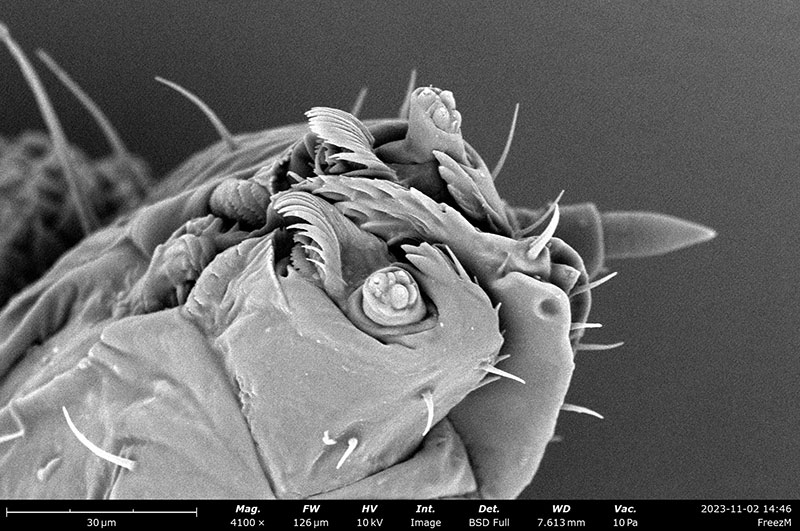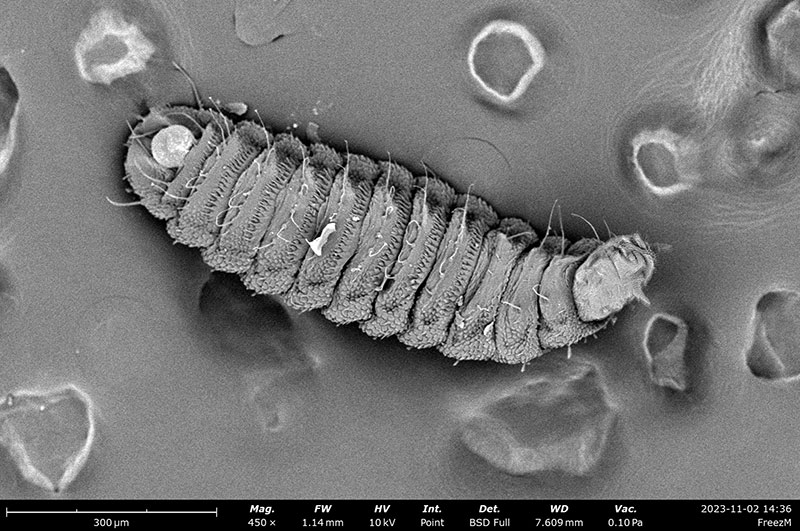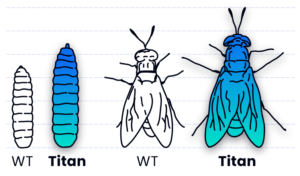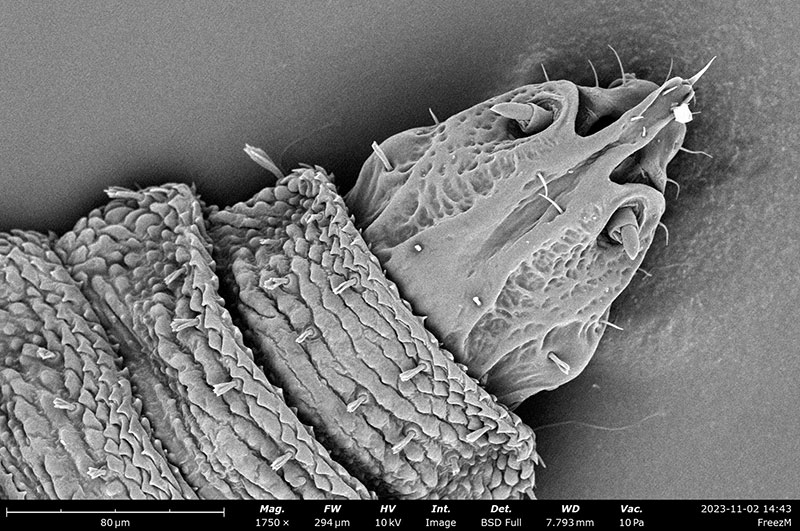In the realm of insects, the Hermetia Illucens, also known as the Black Soldier Fly (BSF), and its larvae have emerged as fascinating subjects of study, capturing the attention of researchers and environmentalists alike. BSF transcends mere entomology. It offers a glimpse into the complex tapestry of nature’s recycling systems. It is a tropical fly species with exceptional organic matter decomposition capabilities and a myriad of applications ranging from protein-rich animal and fish feed to the production of valuable byproducts like oleochemicals and frass. These enigmatic larvae are proving to be ecological game-changers.
The Black Soldier Fly and Its Extraordinary Lifecycle
The Black Soldier Fly, scientifically known as Hermetia illucens, is an insect native to Latin America, but it has expanded to almost every region on the planet. Thriving in temperatures between 25 to 35 degrees Celsius, its broad temperature tolerance makes it adaptable to diverse environments.
What makes these creatures particularly intriguing is their unique life cycle. The adult BSF does not consume solid food and has a lifespan of only a few days, during which its primary goal is to reproduce. The female lays eggs, and once hatched, the larvae become the focus of attention due to their incredible transformative abilities. Larvae undergo a staggering 8,000-fold size increase in a mere 14 days.
To put it in perspective, this rapid growth is like a human baby transforming into a full-sized adult gray whale weighing over
20,000 kg in just a couple of weeks!
Lyfe Cycle
Egg Stage: The life cycle begins with the egg stage, where female black soldier flies lay their eggs in cracks and crevices near decaying organic matter, such as compost or food waste. The female black soldier fly deposits a mass of 200 to 900 eggs at a time, which hatch into larvae in about four days. Each oval-shaped egg is about 1 mm in length.
Larva Stage: The larva stage is where the real action happens. The larvae can reach up to 300mg after six moltings (insters), during which they shed their exoskeleton to accommodate their growing size. They are a dull, whitish color with a small, projecting head containing chewing mouthparts. Larvae require approximately 14 days to complete development. These larvae are voracious eaters with a high turnover rate for the feed, capable of consuming large amounts of organic material in a short time. They play a critical role in breaking down and recycling waste, transforming it into nutrient-rich frass and biomass.
Pupa Stage: During this stage, the larvae stop feeding and search for a place to pupate (pre-pupa). Their walking in line in search of a place to pupate is why the fly got its name – Black Soldier Fly. They enter the pupa stage, where they undergo metamorphosis to transform into adult black soldier flies. Pupation requires about two weeks. This is a non-feeding stage focused on development.
Adult Stage: Adult black soldier flies do not consume solid food. They have a wasp-like appearance and are black or blue in color. They also have two translucent “windows” located on the abdomen. Adults may range from 15 to 20 mm in length and their primary focus is on mating and reproducing, completing the life cycle. They are non-pest insects, ie, beneficial to our ecosystem, and do not cause damage to property or crops, pose health risks or are a nuisance as other insects.
A Striking Appearance
Cloaked in a mysterious blend of white and black hues, BSF (Black Soldier Fly) don a distinctive conical shape optimized for interacting with organic matter. Delicate hairs grace their bodies, lending them an almost otherworldly appearance. Despite their unassuming demeanor, these insects undergo remarkable growth, reaching an impressive size of up to 1 inch (2.5 cm) during their larval stage.

Physical Characteristics
Color: Black Soldier Fly neonates have white tones, but as they grow, larvae are typically dark brown to black. This coloration makes them easy to spot, especially in compost or waste material.
Conical Shape: These larvae have a distinctive conical shape, with a wider posterior end and a tapering, pointed head. This shape aids them in burrowing into their food source.
Size: Black Soldier Fly larvae grow to an impressive length of around 1 inch (2.5 cm) during their larval stage, making them one of the larger fly larvae species.
Fine Hairs: Their bodies are covered in tiny, fine hairs, which may help them move through their environment and interact with their surroundings.
Efficient Waste Converters
These unique characteristics and life stages make Black Soldier Fly larvae valuable contributors to waste management, sustainable agriculture, and various ecological processes. Their efficiency as decomposers and nutrient-rich composition make them an eco-friendly solution to several environmental and food security challenges.
In a mere two weeks, 500 grams of neonate larvae have the astounding ability to devour up to 15 tonnes of waste, generating an impressive one ton of protein in the process.
BSF larvae are highly efficient in converting organic waste into biomass. They can consume a wide range of organic materials. Additionally, they display resilience against microorganisms and parasites, surviving in challenging environments while effectively cooperating with microorganisms to degrade organic waste.
Regulations, though, prohibit feeding certain materials to insects, especially those classified as meat, manure or urban waste. These regulations are very strict on what are permitted insect substrates. These may include vegetal matter, such as cereal grains, legume seeds, roots, fruits, forages and algae, and non‑animal-containing industry by‑products from bakery and confectionery industries and from processing fruit and vegetables. Certain animal by-products as substrates are also permitted, including milk, cooked eggs, and fats…provided that the substrates have undergone processing such as pasteurizing, cooking or baking under the hygiene regulations.
BSF Larvae As a Protein Factory
Dried and frozen Black Soldier Fly larvae can be used in animal feed applications directly or further processed into products such as BSF meal powder, puree and BSF oil.
One of the most significant contributions of BSF larvae lies in their protein content. Studies have shown that these larvae are exceptionally rich in protein and other nutrients, including essential amino acids, unsaturated fatty acids, minerals, and vitamins, making them an ideal candidate for animal and fish feed.
The nutrient amounts largely depend on the quality of food, with about 18–33% fat and 32–53% protein.
With a protein content in the range of traditional feed sources like soy (40-48%) and fish meal (60-68%), BSF larvae present a sustainable alternative that can help address global concerns about the environmental impact of traditional feed production, such as land -and sea resources- exhaustion, water consumption or greenhouse gas emissions.
Research indicates that BSF larvae and BSF meal have excellent anti-inflammatory, antimicrobial, and hypoallergenic properties, resulting in health improvements in the animals that consume them. One of the main applications is in the production of hypoallergenic foods for pets.

A Circular Solution to Organic Waste
Beyond their role in the food chain, BSF larvae contribute to a sustainable and circular economy. As the larvae consume organic waste, they not only reduce the environmental burden of waste disposal but also create valuable byproducts such as oil and frass.
Insect oil is obtained by the process of defatting insect proteins, is highly digestible and provides a sustainable source of energy for many animals. The lipid content of BSF larvae/prepupae is influenced by the feed for growth and can reach more than 50%.
BSF lipids mainly consist of medium-chain saturated fatty acids, with lauric acid (LA) being the dominant component. LA has been reported to exhibit antibacterial, antifungal, antiviral, and anticancer properties. Moreover, it has applications in various fields, such as pharmaceuticals, cosmetics, body care, plastics, and textiles.
The excrement of the larvae, known as frass, is a nutrient-rich fertilizer that contains essential nutrients like nitrogen, phosphorus, and potassium, contributing to soil enrichment and plant growth. However, many aspects related to frass are still unknown, such as its varying composition of nutrients, microorganisms and bioactive compounds, its behavior in the soil and its action in the plants’ metabolism, among other aspects that are subject to numerous studies.
Research Insights: Unlocking the Potential
Scientific research on BSF larvae continues to unveil new possibilities and applications. Studies have explored optimal conditions for larvae growth, refining techniques for mass production, development of strains to increase protein or oil yield, and assessing the nutritional composition of the larvae. The results are promising, pointing towards a future where BSF larvae play a crucial role in sustainable agriculture, waste management, and alternative protein production.
BSF-Titan® is a genetically engineered BSF line developed by FreezeM that aims to enhance its size and protein content through CRISPR-Cas9 gene-editing methodologies. BSF-Titan® is the first Black Soldier Fly line showcasing augmented production performance, exhibiting a 50% increase in larvae size and significantly improving protein production yield.

Conclusion: Paving the Way for a Sustainable Future
In nature’s grand tapestry, Black Soldier Fly larvae are unsung heroes, weaving a story of transformation as they turn organic waste into valuable resources. Their applications range from protein-rich feeds for livestock and aquaculture to eco-friendly fertilizers and industrial chemicals, showcasing the vast potential of these remarkable insects.
As we unravel the mysteries of their world, we discover not only ecological solutions but also a path toward a more sustainable and harmonious future. The multifaceted benefits of Black Soldier Fly larvae serve as a testament to the beauty of nature’s intricate design and its capacity to address the challenges of our time.
